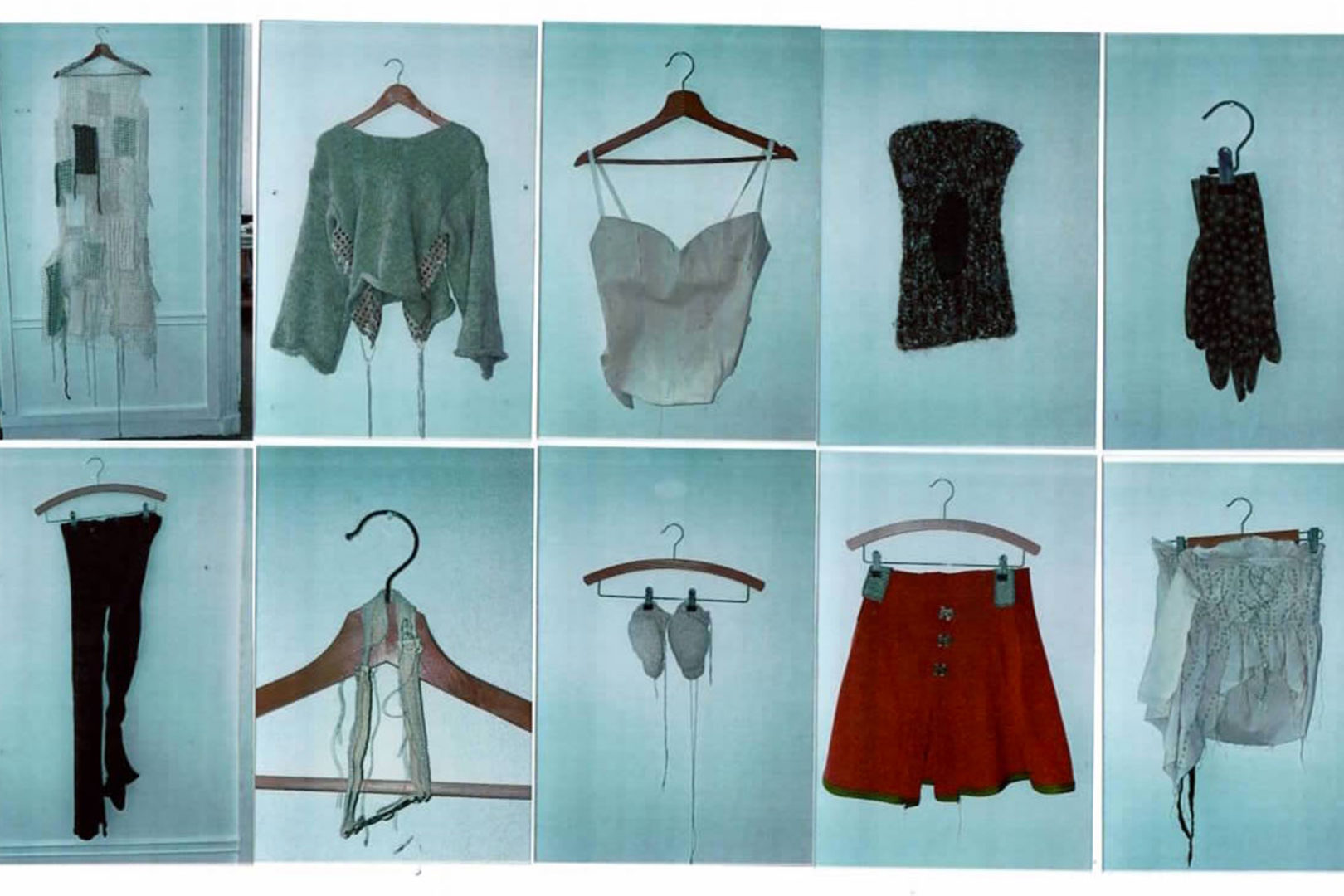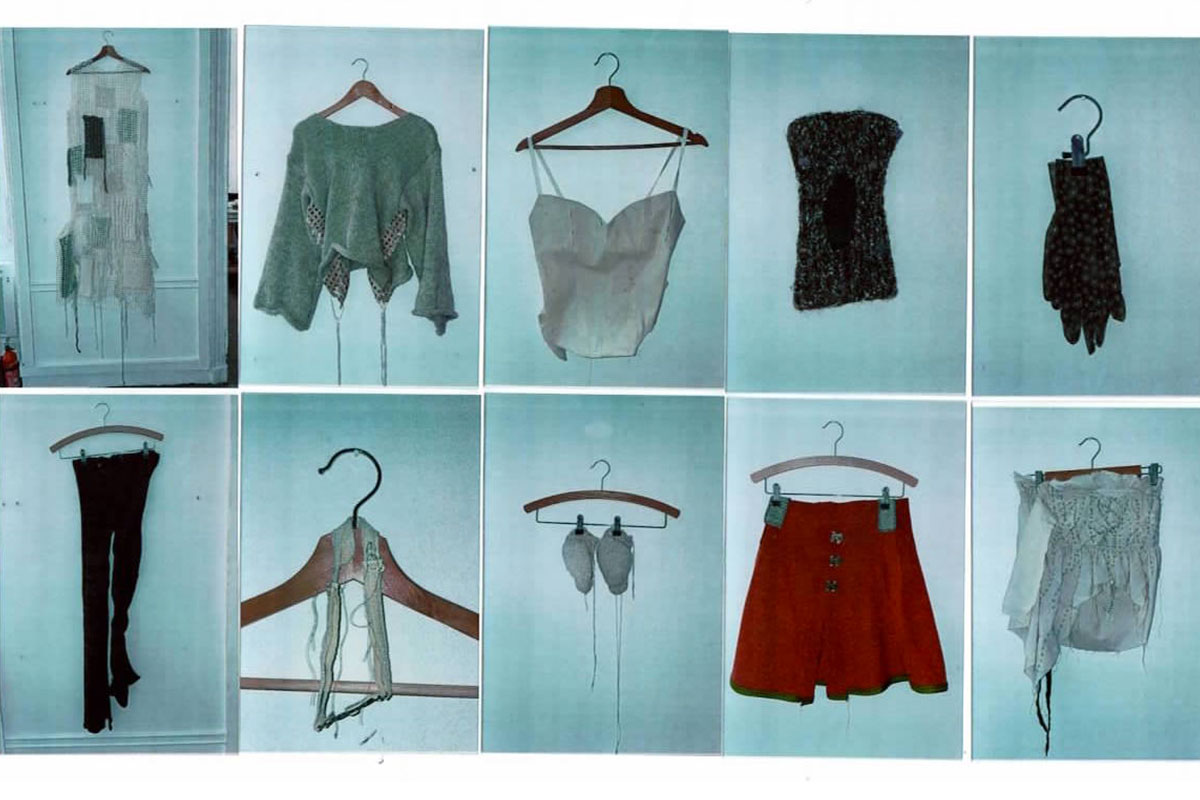The brand carving new shapes of communication. Louise Lyngh Bjerregard is all about exploring vulnerability and investigation through upcycled materials
Louise Lyngh Bjerregaard. The rise of a new generation’s artisanal brand
Louise Lyngh Bjerregaard creates a discursive and mimetically layered brand where transparency and sustainable consciousness become a performative act. Bjerregaard emerged on the Parisian scene when she moved her atelier from Denmark during the pandemic.
Her collections playing with the distance between the body and the garment, with forbidden textures such as thin knitting or upcycled furniture fabrics showcase the young designer’s training with a mentor who worked with Pierre Cardin. For Bjerregaard, clothing becomes «a tool to navigate the world» while having a considerate approach since «it’s difficult to justify why you create more when there’s so much in the world already».
With previous training under brands like Anne Sofie Madsen and Eckhaus Latta, Louise Lyngh Bjerregaard formed her homonym label through imaginative ways of communication such as exhibitions, videos, and installations.
The brand’s clothing contains a universality aura, deprived of national identity that «doesn’t belong to one country. It just belongs to everyone». As Bjerregaard explains, «I don’t identify that much with being Danish. So I think that’s also what I appreciate about creating: it can set you free».
The sense of liberty is present throughout the creative process. Here, muses, mood boards, or logos become too fixed and structured for a brand that refuses boundaries. In the eyes of the young designer, «clothing is a lifestyle itself. So I think, in general, clothing is just really a tool for being playful and trying to investigate life».
With a conceptualized representation as her name, taking a squared shape that resembles a maze, the Louise Lyngh Bjerregaard logo is hidden in the garments print for the loyal consumers to find. Although she reveals that «you divide people based on how your brand identity is visualized», she intends to embrace, not diverge.
Serendipitous use of textures and craftsmanship
Resembling the material sensibility of the Arte Povera movement, where the emotionally investigated element is the fabric and the medium, Louise Lyngh Bjerregaard’s cloth collecting method is like a witness of her feelings.
«The material stems from all these different ranges of emotions, and suddenly, if you have to follow a mood board, you’re limited to only trying to locate the fabric that translates this feeling or this mood. It’s like learning how to communicate when the material is the only mood you have», Bjerregaard confesses.
In her works, the matter leads the design path, and the sourcing of materials is spontaneous and fluid. «I’ve been building up this practice of sourcing as I go. That’s how I ended up using furniture materials or other types of materials from hardware stores. So it’s kind of like me finding things along the way. And, sometimes, it’s more intentional than others because the textiles resemble an everyday life of a person».
The expressively experimental approach stays at the core of the label’s personality. Bjerregaard reveals how she almost got kicked out of school during her tailoring studies for showcasing coats covered in grass or garments constructed out of sponges and shavings used for cattle and horses.
The visual language of the label
She knitted with foam tubes and coffee bags throughout her attendance at the Central Saint Martins knitwear course. She did so constantly trying to incorporate other mediums in her practice. Cutouts, volumes, and network, second-skin layers contrasting with reshaped extremities. The visual language of the label «is like a symbiosis between the strong and the fragile, two poles present in all people».
However, the most recognizable texture in Bjerregaard’s designs is a spiderweb-thin and transparent yarn she mastered at Central Saint Martins. Financial boundaries led the designer to the only fabric she could access in her studies period. Bjerregaard explains the process’s patience since the yarn is not a monofilament and has to work its weak layer through many metal needles. «So far, I’ve been working with this yarn for six years. I enjoy so much about working with it that it’s become my best friend. Even though it’s challenging», the designer says.
Like a commitment manifesto, the relationship between Louise Lyngh Bjerregaard and the materials she uses goes beyond garment making, becoming a mindset: «You have to commit to things to make them good. That’s also how it is with any relationship. You have to commit and commit through the difficult times, and that’s how you move forward. I mean, I’ve had some of my things copied by some bigger brands, but I think that’s how I was able to master this technique to an extent where it’s almost impossible for other people to copy it».
Building a brand narrative through artistic displays
The performative practices and installments Bjerregaard operates with are challenging nowadays transparency communicating strategies. The spotlight shifts towards the fabric and the people behind the scene.
To launch her AW21 collection, the designer chose to move her atelier in London’s Wood Woodshop. «What’s happening every day in my atelier is unique. And not many people get to see this side. Maybe that captures the essence of my brand, that it’s a life that’s happening. And when it’s not just me when I have a team, it involves more lives, and it’s people’s passion».
By exposing her work in utility wear and high-end outerwear shop, Bjerregaard is breaking some of the fashion stigmas. She does so illustrating the process of making a knit dress that takes months to create. As she explains, «you have to educate the bias of why this dress costs 600 euros or 1000 euros?».
During the one month of the installment, people coming into the shop could join the performance and actively experience what it takes to make a seam and calculate pattern cutting. «It’s okay for everybody not to know everything, and I think it’s entirely satisfactory just to be intrigued by something that you don’t know how to do. But the appreciation and sharing of knowledge and opening up one universe to another and just inviting people in, I believe, is crucial», says Louise Lyngh Bjerregaard.
Fall/Winter 22 collection
For the Fall/Winter 22 collection, Bjerregaard collaborated with a director from Berlin. They created a movie exploring the message she is trying to communicate to people. The video developed the concept of surveillance. The spectators could feel like «they’re not just seeing a fashion show. They’re actually invited to see more things than the people attending the show».
Casting close-ups flavored the images of backstage and front-stage monitoring cameras merged with runway reproductions: «it was trying to show the whole universe as much as possible. To kind of show that even though you have full transparency, things can still be intriguing and mysterious; even though you see everything, there’s still the air of mystery».
Ever since the inception of her brand, Louise Lyngh Bjerregaard has collaborated with artists and galleries, disrupting the rigidity of catwalks with more poetically oriented storytelling. One of her latest textile performances debuted in 2021 at the Moderna Museet Malmö, where she collaborated with artist Lukas Hofmann for the Into the Unknown show.
Clothings support human interactions with an audience
«Luke approached me at a time where I had just presented the show during couture week in Paris, and everything was very fashion related and had to fit into this context. So his proposal of us doing work together again came at a time when I wanted to set myself free of fashion», the designer explains.
Their work for this installment is about breath-play. Unfolding an emotionally powerful sensation that can restrain and set free the spectatorship. Bjerregaard embraces the artist’s capacity of creating a liberating mental space, mirroring what she translates through the clothes. «The performative aspects of my practice are a way to free myself and to disrupt everything and throw things back up in the air», confesses the designer.
The performative approach opens up discussions on the space where fashion is showcased. Fashioning your designs to expose them on a catwalk or magazine does not appeal to the Danish designer. She views clothing as «designed to support human interaction while communicating to an audience».
Eventually, Louise Lyngh Bjerregaard duo with Lukas Hofmann is about the relationship between two bodies. «When I place a model on a runway with clothing on, the main focus is the clothing. But with Lucas, I see my clothing supporting the model or the performer, the human interaction».
Sustainability, upcycling and its future perspective
We can consider the small businesses’ efforts that meet different challenges still leaving a harmful imprint on sustainable practices. «Even though it’s slow fashion, it’s still a fast-paced industry if you want to be in it. But I think being fast-paced is not a negative thing. Instead, I see it as a way to get you from A to B to communicate with more people and get your work out».
Being a slow fashion brand that operates with upcycling techniques, Bjerregaard faces the difficulties of a profit-based industry, noting that «it’s difficult to pay the heating bills in your studio when you work with upcycled dead-stock materials that are limited in quantity». Even when the retailers, stylists, and consumers completely align with promoting the benefits of surplus and upcycled stock, there are social issues to consider.
«There’s a price difference when producing in the hundreds, in a factory, or in an atelier, where you have to pay the local taxes». For the young designer, «this gap makes it challenging to have a sustainable business if you’re interested in living from it. It is difficult for productions to take small quantities in and buy small quantities when they consider that to be 200 or 500 pieces».
Louise Lyngh Bjerregaard
Paris-based atelier that works across seasons, blurring the boundaries between ready-to-wear and couture. Founded on craftsmanship, the passion for textiles, and meticulous attention to detail. The brand holds a strong focus on technical sensibility while uniting art, fashion and subversion. An alumnus of both Eckhaus Latta and Anne Sofie Madsen, Louis graduated in 2017. Her work features at institutions such as Maison du Danemark (Paris, FR); National Gallery of Denmark (DK); Moderna Museet Malmö (SWE); and Overgaden Institute for Contemporary Art (DK).




















